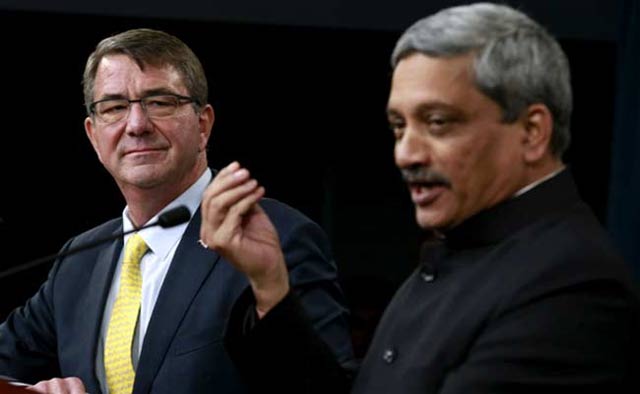
Pakistan apprehensive of US-India defence dea
This undertaking goes beyond the scope of two security-related arrangements of the past. In the first instance, the US and some other Western powers provided weapons and training facilities to India in the aftermath of the Sino-Indian war of 1962. India received such support without any reciprocal treaty obligation although it allowed the US to spy on China from its territory. From 1963, India began to receive Soviet weapons, including the first MiG aircraft. The second instance was the Indo-Soviet Treaty of Friendship and Cooperation of August 1971. The treaty's text was crafted in a manner that it could not be described as a purely bilateral military treaty. However, the Soviets provided weaponry and diplomatic support to India for the 1971 war with Pakistan.
Now, in 2016, India under Prime Minister Narendra Modi has entered into a formal military arrangement with the US, which shows a major shift in the policies of both countries. The Modi government has gone far ahead of the previous BJP government under Atal Behari Vajpayee with reference to its relations with the US. This negates India’s traditional non-aligned posture, although some analysts would argue that it had long abandoned this policy to get close to the US in the post-Cold War era. Three major factors explain this departure in India’s foreign and security policy. First, the Modi government is promoting a Hinduism-based ultra-nationalism in the domestic context with the support of the Sangh Parivar that upholds an extreme right-wing and Hindu fundamentalist vision of India. In foreign policy, it advocates greater Indian assertiveness and a hard line towards external adversaries. Such a strident approach to foreign policy is strengthened from military and diplomatic cooperation with the US. Second, the global foreign policy agendas of China and India are bound to clash in five to 10 years' time. China is on the way to becoming a global power. India is an aspirant for such a status. China’s One Belt, One Road policy of global economic connectivity and trade has caused serious concerns in India and the US because such inter-continental connectivity gives much diplomatic and economic clout to China. In this connection, the CPEC gives a relatively secure sea access to China as there are no hostile states in the vicinity of Gwadar in comparison to the situation in South China Sea. However, US naval ships are often present in the area and these would increase surveillance of China’s activity in Gwadar. A military cooperative arrangement between the US and India that includes the opening up of all Indian military bases to the US, serves the Indo-US shared agenda of keeping China under check.
US, India sign agreement to share military assets, bases
Third, India’s current repression in Indian-administered Kashmir has come to the notice of the international community. Pakistan is expected to raise this issue in a more vocal manner in the forthcoming UN General Assembly session. By linking up with the US military agenda in the expanded Asian region, India hopes to restrain the US and some of its allies from publicly criticising its ongoing efforts to suppress the Kashmiri struggle by coercive means.
The US has made two additional concessions to India. It has proposed an India-Afghanistan-US dialogue on the Afghanistan situation, and has extended full support to India’s cross-border terrorism allegations against Pakistan. The US is attempting to kill two birds with one stone: bring India in line with the US military agenda in the region and increase diplomatic pressure on Pakistan. If the efforts of four powers (Afghanistan, China, Pakistan and the US) could not find a solution to Afghanistan’s troubles, how could the US succeed by knocking out China and Pakistan from the process? If it is a question of Afghanistan’s economic reconstruction, India can be helpful. However, if the idea is to settle the internal strife in Afghanistan, this is an unrealistic proposal, which ignores geographic realities. Further, the Afghan Taliban view the US, Afghanistan and India as their adversaries and they are not expected to enter into a dialogue with them for a political settlement in Afghanistan.
In view of US support, the Indian government will display more arrogance and belligerence than ever in its diplomatic interaction with Pakistan. It will insist more on a single-issue agenda of India’s choice, for talks with Pakistan, i.e., Pakistan must satisfy India on the terrorism issue first while rejecting Pakistan’s proposal for a mutually agreed agenda for the talks. Similarly, Afghanistan will also adopt a more hostile disposition towards Pakistan, knowing fully well that such a policy is in harmony with the policies of India and the US.
The US has increased direct diplomatic pressure on Pakistan to force the latter to pursue a counterterrorism policy to Washington’s satisfaction. Its top leadership has joined hands with Indian leaders to publicly censure Pakistan on terrorism in the region. This policy will further reduce the prospect of any meaningful dialogue between India and Pakistan. The regional situation will slide towards more acrimony and conflict. India and the US will not be able to tame the Afghan Taliban and thus the current internal strife in Afghanistan will aggravate.
Published in The Express Tribune, September 5th, 2016.
Like Opinion & Editorial on Facebook, follow @ETOpEd on Twitter to receive all updates on all our daily pieces.









































COMMENTS (23)
Comments are moderated and generally will be posted if they are on-topic and not abusive.
For more information, please see our Comments FAQ